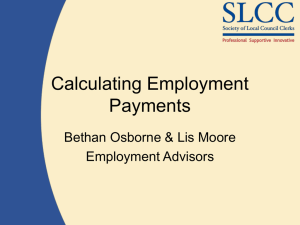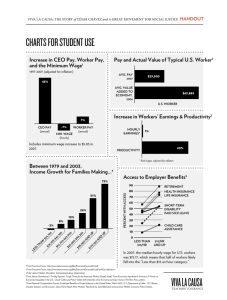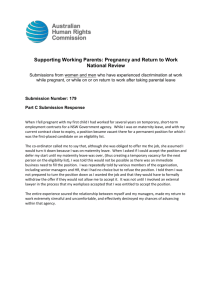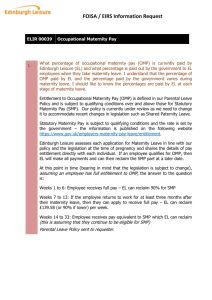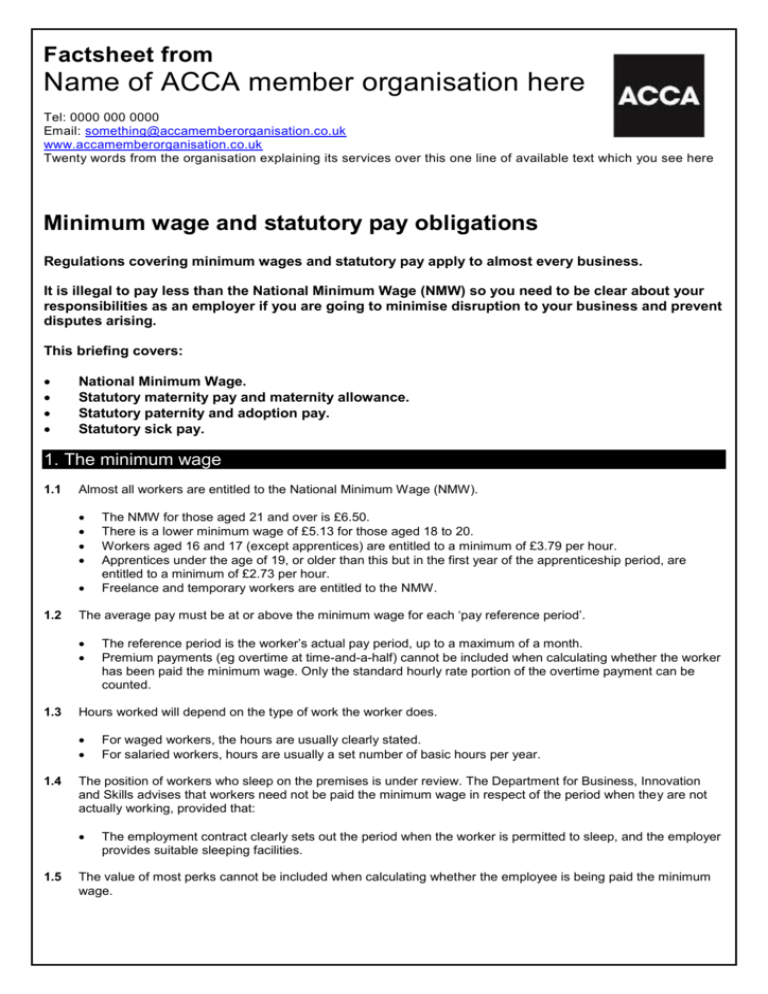
Factsheet from
Name of ACCA member organisation here
Tel: 0000 000 0000
Email: something@accamemberorganisation.co.uk
www.accamemberorganisation.co.uk
Twenty words from the organisation explaining its services over this one line of available text which you see here
Minimum wage and statutory pay obligations
Regulations covering minimum wages and statutory pay apply to almost every business.
It is illegal to pay less than the National Minimum Wage (NMW) so you need to be clear about your
responsibilities as an employer if you are going to minimise disruption to your business and prevent
disputes arising.
This briefing covers:
National Minimum Wage.
Statutory maternity pay and maternity allowance.
Statutory paternity and adoption pay.
Statutory sick pay.
1. The minimum wage
1.1
Almost all workers are entitled to the National Minimum Wage (NMW).
1.2
The average pay must be at or above the minimum wage for each ‘pay reference period’.
1.3
For waged workers, the hours are usually clearly stated.
For salaried workers, hours are usually a set number of basic hours per year.
The position of workers who sleep on the premises is under review. The Department for Business, Innovation
and Skills advises that workers need not be paid the minimum wage in respect of the period when they are not
actually working, provided that:
1.5
The reference period is the worker’s actual pay period, up to a maximum of a month.
Premium payments (eg overtime at time-and-a-half) cannot be included when calculating whether the worker
has been paid the minimum wage. Only the standard hourly rate portion of the overtime payment can be
counted.
Hours worked will depend on the type of work the worker does.
1.4
The NMW for those aged 21 and over is £6.50.
There is a lower minimum wage of £5.13 for those aged 18 to 20.
Workers aged 16 and 17 (except apprentices) are entitled to a minimum of £3.79 per hour.
Apprentices under the age of 19, or older than this but in the first year of the apprenticeship period, are
entitled to a minimum of £2.73 per hour.
Freelance and temporary workers are entitled to the NMW.
The employment contract clearly sets out the period when the worker is permitted to sleep, and the employer
provides suitable sleeping facilities.
The value of most perks cannot be included when calculating whether the employee is being paid the minimum
wage.
1.6
The value of accommodation provided free can be included, but only up to a value of £35.56 a week.
The value of perks which can be freely exchanged for money, goods or services is included (eg incentives
and bonuses).
Tips do not count towards the minimum wage, unless collected by the employer and paid through the normal
pay system.
There is no opt out from the NMW.
1.7
You need to keep adequate pay records to prove you are paying the minimum wage. If workers suspect they are
underpaid, they can request, inspect and copy any records that will establish whether this is true or not.
1.8
Workers cannot agree to be paid less.
Workers must be paid the minimum, no matter how poor their performance is.
Dismissing a worker to avoid paying the minimum wage is automatically unfair.
Directors of a start-up must be able to show that they pay themselves at least £6.50 an hour.
You must respond to a request for relevant information within 14 days.
Records don’t have to be kept in a specific format. If most of your employees are paid well above the
minimum wage, you may not need to keep any additional records beyond those you already keep for PAYE.
In case of dispute, you will have to prove that you have paid the minimum wage.
The minimum wage is enforced by HM Revenue & Customs (HMRC).
It has the power to demand records, enter premises and interview employees.
It may detect breaches of the minimum wage requirements on your PAYE returns.
Failing to keep adequate records, keeping false records, and obstructing an enforcement officer are all
separate criminal offences. You could be liable for fines of up to £5,000 for any of these offences.
If it is discovered that an employer is not paying the minimum wage, they will have to pay arrears within 14
days and a penalty equal to 100% of the unpaid wages owed to workers up to a maximum of £20,000 per
worker. If the employer still fails to pay, they risk prosecution and an additional fine.
2. Maternity pay
Many pregnant women on ordinary maternity leave are entitled to statutory maternity pay (SMP).
This is treated as income and standard rates of SMP are paid net of income tax and National Insurance contributions
(NICs).
2.1
To qualify for SMP, a woman must have completed 26 weeks’ service by the end of the 15th week before the
week the birth is due. This is known as the ‘qualifying week’.
2.2
She must have average weekly earnings of at least the lower earnings limit of £111 per week in the eight
weeks up to and including the qualifying week.
She must still be pregnant, or have had her baby, by the 11th week before the expected week of childbirth.
She must have stopped working, or taken ordinary maternity leave.
She must have provided evidence of the expected date of birth.
There are two rates of SMP.
A woman entitled to SMP receives the higher rate, equal to 90% of her average weekly earnings if more than
£138.18 per week, for the first six weeks.
She then moves to a fixed rate of £138.18 or 90% of her average earnings if lower for up to 33 more weeks.
These are set rates and are not altered in the case of multiple births.
The level of SMP has to be recalculated if a pay rise takes effect at any time between the start of the
reference period and the end of the maternity leave, both ordinary and additional.
2.3
Employees not entitled to SMP may qualify for maternity allowance (see 3).
2.4
The Government compensates employers for making statutory payments to new parents.
2
Small businesses can claim back more than they pay out.
You can claim 103% if you are a small enterprise with total NI payments (employer’s and employees’ combined)
of £45,000 or less a year.
Larger employers can reclaim 92% of the gross amounts paid.
You can claim back the amount paid by making deductions from the NICs you usually pay to HMRC.
You must maintain detailed records and keep them for at least three years.
2.5
SMP stops if the employee is taken into custody, or dies.
2.6
Mothers can work for ten days during maternity leave (known as ‘keeping in touch days’) without it affecting
their right to SMP.
Some employers offer enhanced maternity pay to some or all of their female employees.
3. Maternity allowance
3.1
Maternity allowance (MA) is paid by Jobcentre Plus and is based on the woman’s recent employment and
earnings record.
3.2
Those who are self-employed, or a pregnant employee who is recently employed, or does not qualify for
SMP, may qualify for MA.
These include women who earn between £30 and the lower earnings limit a week and have been employed
or self-employed for at least 26 weeks of the 66 weeks ending with the week before the expected week of
childbirth.
They must earn on average at least £30 per week.
MA is paid for a maximum of 39 weeks at £138.18 per week or 90% of average weekly pay if lower. Get full
details of the SMP and MA schemes on the GOV.UK website at www.gov.uk/maternity-allowance/overview.
4. Paternity pay
4.1
Fathers (or those with responsibility for bringing up children) are entitled to take paid time off at or around the
time of the child’s birth. Those employees who qualify for paternity leave are entitled to ordinary statutory
paternity pay (SPP).
4.
SPP is for either one or two consecutive weeks as specified by the employee.
The rate of SPP is £138.18 per week or 90% of average pay, if lower.
Employees who have weekly earnings below the lower earnings limit for National Insurance purposes do not
qualify for SPP.
As with SMP, employers claim back the SPP by making deductions from the NICs they usually forward to
HMRC.
Male employees who become fathers, or who receive notification that they have been matched with a child for
adoption, qualify for additional paternity leave and pay (APL&P)
APL allows the employee to take up to 26 weeks’ leave to care for their child.
They can only start their leave 20 or more weeks after the child’s birth or placement for adoption, and when
their partner has returned to work from statutory maternity leave or adoption leave, or ended their entitlement
to SMP or adoption pay.
Any employee wishing to take APL must give eight weeks’ notice of when they want their APL to start.
The rate of APP is £138.18 a week or 90% of average pay, if lower.
Since 1 October 2014, fathers, partners and parents have also had the right to take unpaid time off work to
attend up to two ante-natal appointments.
3
5. Adoption pay
5.1
Adoption leave and statutory adoption pay (SAP) is available to employees who adopt, or one member of a
couple where the couple adopt jointly.
Most adopters are entitled to £138.18 a week or 90% of average pay if lower for up to 39 weeks.
Adopters who have average weekly earnings below the lower earnings limit for NICs do not qualify for SAP.
As with SMP and SPP, employers can recover the amount of SAP paid by offsetting the amount against
NICs.
Any additional adoption leave – including time off to attend up to two ante-natal appointments - is unpaid.
A right to paternity leave and pay for the other member of the couple, or an adopter’s spouse or partner, is
also available.
6. Statutory sick pay
6.1
Statutory sick pay (SSP) is paid up to a maximum of 28 weeks, to workers (including part-time, full-time and
agency workers) who are unable to work because of sickness.
6.2
To be entitled to SSP a worker must:
6.3
If a worker qualifies for SSP (see 6.2), it is paid at a flat rate of £87.55 a week.
There is no qualifying length of service or minimum number of hours a week.
Even if it is a worker’s first day of work with a new employer and they become sick part way through the day,
they may be entitled to SSP.
Be sick for at least four or more days in a row (including weekends and bank holidays).
Have earnings over the NI lower-earnings limit.
Workers become entitled to SSP from the fourth ‘qualifying day’ of sickness.
A qualifying day is basically a day on which the worker would normally have worked.
6.4
You are entitled to ask for evidence that a worker is unfit for work. This will usually be in the form of a note from
their doctor.
6.5
For the first seven days that they are sick, a worker must fill in a self-certificate of their own or form SC2
(employee’s statement of sickness) which can be obtained from a GP’s surgery or HMRC’s website
(www.hmrc.gov.uk).
If a worker is receiving SSP for a pregnancy related illness at the start of, or in the four weeks before her baby is
due, SSP will stop and any entitlement to statutory maternity pay (SMP) or maternity allowance (MA) will start
automatically.
6.6
In practice, the rule means that there are usually three clear ‘waiting days’ before SSP is payable in any
‘period of incapacity for work’ (PIW).
If the worker is sick on a weekend day or a Bank Holiday — or any other non-working day — this counts
towards the four-day PIW, but is not a ‘qualifying day’.
Employers must issue form SSP1 by the end of the 23rd week to let the worker know when SSP will be
ending.
If she is entitled to SMP or MA, she cannot receive SSP for 26 weeks starting with the day of entitlement to
those payments.
If she is not entitled to SMP or MA, she cannot receive SSP for 18 weeks starting with the Sunday of the
week her baby is born, or the Sunday of the week she is sick from work for a pregnancy related illness.
You can withhold SSP if the worker:
4
6.7
Has recently drawn a state benefit (such as maternity allowance or Employment and Support Allowance).
Is held in custody.
Employers must keep full records of SSP.
Records must be kept for three years.
Failure to do so can lead to a £1,000 fine.
7. Getting help
Because of new legislation and the effects of case law, printed material on statutory pay obligations quickly goes out of
date.
7.1
The best up-to-date information is often available from Acas on 0300 123 1100 or at www.acas.org.uk.
7.2
For advice on the NMW, call the Pay and Work Rights Helpline on 0800 917 2368.
7.3
For information on SMP, SSP and other aspects of NICs and PAYE, contact the HMRC employers’ helpline
on 0300 200 3200.
7.4
For interactive tools giving guidance on employment rights, visit www.gov.uk/browse/employing-people.
Note
Employment law is complex and is changing rapidly. This briefing reflects our understanding of the basic legal position
as known at the last update. Obtain legal advice on your own specific circumstances and check whether any relevant
rules have changed.
Expert contributors
Thanks to Bethan Southcombe (NewLaw solicitors, 0845 521 0945).
Last updated 01.10.14
© Atom Content Marketing 2014. ISSN 1369-1996. All rights reserved. No part of this publication may be reproduced or transmitted without the
written permission of the publisher. This publication is for general guidance only. The publisher, expert contributors and distributor disclaim all liability
for any errors or omissions. Consult your local business support organisation or your professional adviser for help and advice.
5

